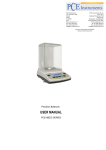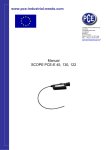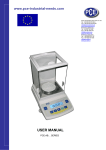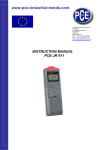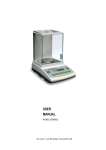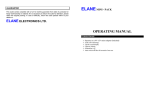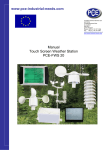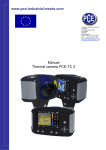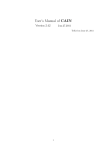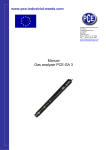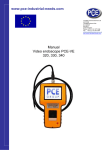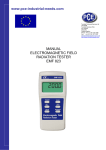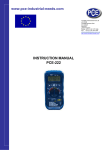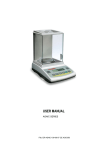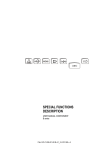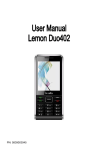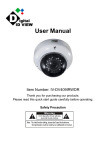Download www.pce-industrial-needs.com Manual Balanza dosificadora PCE
Transcript
www.pce-industrial-needs.com Tursdale Technical Services Ltd Unit N12B Tursdale Business Park Co. Durham DH6 5PG United Kingdom Phone: +44 ( 0 ) 191 377 3398 Fax: +44 ( 0 ) 191 377 3357 [email protected] http://www.industrial-needs.com/ Manual Balanza dosificadora PCE-ABZ 200C [email protected] 1. 2. 3. General description ........................................................................................................ 3 Completeness ................................................................................................................. 3 General view ................................................................................................................... 3 Front view: .......................................................................................................................... 3 Rear view: ........................................................................................................................... 4 4. Keys and indicators ....................................................................................................... 4 5. Technical Data ................................................................................................................ 5 6. Security rules .................................................................................................................. 5 7. Preparations – working environment ........................................................................... 7 8. Preparation – the balance .............................................................................................. 8 9. Operation principles....................................................................................................... 8 10. Testing and calibration .................................................................................................. 9 11. External calibration / calibration options ..................................................................... 9 Operations sequence: ..................................................................................................... 10 12. Internal calibration (autocalibration) .......................................................................... 11 Internal calibration settings (time intervals and temperature changes) ..................... 11 13. Connecting a balance to a computer or a printer ...................................................... 12 1. Standard mode: ............................................................................................................ 12 2. Automatic mode: .......................................................................................................... 12 14. Special functions description...................................................................................... 14 15. Legend ........................................................................................................................... 14 16. Normal weighing........................................................................................................... 14 17. Weighing with tare........................................................................................................ 14 18. Autozeroing (Aut …)..................................................................................................... 15 19. Pieces counting (PCS) ................................................................................................. 15 20. Serial port setting (rS-232CS) ...................................................................................... 16 21. Date and time setting (F..-dAt)..................................................................................... 17 22. Maintenance and repairs of small defects ................................................................. 17 Error communicates: ....................................................................................................... 18 2 [email protected] 1. General description PCE-ABZ...C series balances are destined for high accuracy weighing in laboratory practice. Balances are equipped with an internal calibration system for proper accuracy control during operation. The user should also own weight standard of OIML F2 or F1 class for periodical control of the balance (weight value stated in Technical Data sheet) - available separately. All balances are metrologically tested - calibration on demand. 2. Completeness A standard set consist of: 1. Balance 2. Tin floor plate and pan ring, 3. Pan support and pan 4. Feeder ZN 12V/500mA, 5. User Manual, 6. Guarantee card. 3. General view Front view: 1 – pan 2 – support pan 4 – display LCD 5 – keyboard 6 – legs 7 – water-level 9 1 2 3 4 8 5 7 6 3 [email protected] Rear view: Feeder Adjust switch RS232C 1 ON OFF RxD(receiver) TxD(transmitter) 2 6 7 3 8 4 GND 5 9 Case 4. Keys and indicators Max Min e d I 4 [email protected] key key key key key key →T← →0← Menu I/ - tare (subtract package weight from weighed mass) numeric key / zeroing (balances for direct sale use only), numeric key / data output (print / transmission), numeric key / internal calibration on and off, numeric key / Menu, switch-on/switch-off (standby), indicator bar indicator indicator OFF Max, Min, d, e, II - result stabilisation, load indicator 0 ÷ 100%, stand-by mode, metrologic parameters and accuracy class. 5. Technical Data Type Capacity (Max) Min load (Min) Reading unit (d) Verification unit (e) Tare range Accuracy class Working temperature Weighing time Pan dimension Balance base dim. (including legs) Weighing chamber dimensions Power Balance weight Calibration weight (OIML) 100g 10mg 0,1mg 1mg -100g 200g 10mg 0,1mg 1mg -200g I +18 ÷ +30 °C <8s φ90mm 215(235)x345x350mm 175x140x230mm ~230V 50Hz 9VA / =12V 300mA 6,5kg E2 100g E2 200g 6. Security rules 5 [email protected] To avoid electrical shock or damage of the balance or connected peripheral devices, it is necessary to follow the security rules below. • All repairs and necessary regulations can be made by authorised personnel only. • To avoid fire risk use a feeder of an appropriate type (supplied with the balance). Pay attention that supply voltage is compatible with specified technical data. • Do not use the balance when its cover is opened. • Do not use the balance in explosive conditions. • Do not use the balance in high humidity. • If the balance seems not to operate properly, unplug it from the mains and do not use until checked by authorised service. According to legal regulations it if forbidden to dispose electronic equipment in waste containers. • Please return wasted balance to the point of purchase or other company specialised in recycling of wasted electronic components. 6 [email protected] 7. Preparations – working environment +30°C +18°C When choosing a location to set up the balance, remember the following rules to ensure proper working conditions and user-friendly operating: - Setup the balance on an even, flat surface leaving necessary room for easy access. - Maintain proper working temperature. - Avoid strong air drafts, vibrations, dust, big temperature changes and humidity over 75%. - Avoid locations with extreme heat radiation and electrometric PCE-ABZ 100C or metric PCE-ABZ 200C fields. 7 [email protected] 1 8. Preparation – the balance 2 3 1. Take the balance and supplied accessories (a feeder, pan elements) out of the box. 2. Place the balance on a stable ground not affected by mechanical vibrations and airflows. 3. Level the balance with rotating rear legs 6 so that the air bubble in water-level 7 at the back of the balance is in the middle. 4. Place tin floor plate 4 and the pan ring 3 in the weighing chamber and gently put on the pan support 2 and finally the pan 1. 4 5. 7 Plug a feeder to the power socket at the back of the balance. 6 Moisture in the air may condense on the surface of the balance when transferred to the warmer environment. In this case leave the balance for at least 4 hours unplugged from the mains for conditioning to avoid wrong operating or damage of the balance. Leave the pan empty and plug the feeder to the mains. At the end of self-tests, the balance displays zero indication and is now ready to work. 9. Operation principles Do not overload the balance more then 20% of maximum load (Max). Do not press the pan with a hand. Before transportation take off the pan (move it slightly and lift it up) and the pan base and preserve from any damages. 1. To ensure proper weighing accuracy the balance is equipped with internal calibration system. The system automatically calibrates the balance every 2 hours and with temperature changes more than 1°C (values modification possible) without user intervention. When the balance is moved to another localisation remember to level the balance and proceed with internal calibration. 2. Weighed sample should be placed in the centre of the pan. 3. In balances equipped with 0 key and with d=e, make sure that zero indicator is displayed. If not, press 0 key and wait until zero indication and zero indicators appears. In other balances the key does not operate. 4. The balance is equipped with a tare equal to its range. To tare the balance press →T← key (left or right). Storing a tare value does not extend measuring range, but only subtracts it from a load placed on the pan. To make weight control easier and to avoid range overdrawing, the balance is equipped with a load indicator (graduated in percentages). 5. Weighing result should be read when the indicator " “lights, which signalises stabilisation of a result. 6. When the balance is not used but it is necessary to be ready to work immediately, it can be switched off by pressing I/ key. The balance reading system is then switched off to "standby" mode (signalled by the indicator "OFF"). To switch the balance on press I/ key. The balance is immediately ready to operate maximum accuracy (after self tests). 7. The mechanism of the balance is a precise device, sensitive to mechanical strokes and shocks. 8 [email protected] 8. The balance should not be used to weigh aerometric PCE-ABZ 200C materials due to accuracy decrease. 10. Testing and calibration To ensure reliable results it is advised to check balance accuracy with an object of precisely known weight before and after each measuring session. To check a balance with EC verification use a weight standard as stated in Technical Data table for specific balance type (or of better accuracy) with valid calibration certificates. In case permissible error is exceeded please contact an authorised service. 11. External calibration / calibration options Calibration with external weight standard in verified balances should be performed in case balance indications exceed permissible error. To calibrate the balance a service centre should use calibration weight as stated in Technical Data table (or of better accuracy) with valid calibration certificate. External calibration in verified balance should be performed in authorised PCE services, as it is possible only after removing protective seals. In this case the validity of the verification is void and the balance must be re-verified by the nearest Notified Body or at the place of installation. In balances with EC verification calibration function is blocked for the user. It is only possible to print calibration report useful for routine balance check-through. The report printout example Date: ... Time: … CALIBRATION REPORT ---------------------------------------------------FACTORY NUMBER: ... PROGRAM NUMBER: ... - Internal weight value registered during factory calibration. - Internal weight value registered during last calibration. CALIBRATION PRIMARY MASS: ... CALIBRATION MASS: ... DIFFERECE MASS: ... - Difference between internal weight values: factory value–current value (PCE-ABZ 200C diosis). 9 [email protected] Operations sequence: 0.0000g MENU CAL ... C_LOAD Press MENU to call functions and press →T← to choose calibration "CAL ..". T T Press →T← to choose "C_LOAD" and calibration weight value. m1 m2 ... m T CAL-EXt T Press →T← to choose "CAL_EXt". -----m Wait until zeroing process is finished. LOAD When "LOAD" communicates put a calibration weight on the pan. CAL Wait until calibration process is finished. unLOAD CAL When "unLOAD" communicate appears remove the calibration weight from the pan. Wait until internal calibration is finished. WAIT 0.0000g 10 [email protected] 12. Internal calibration (autocalibration) Internal calibration is performed automatically after each start-up, also in defined time intervals and temperature changes. To calibrate the balance with internal weight, simply empty the pan and press key. The beginning of internal calibration is signalised with –CAL– communicate on the display. Internal calibration settings (time intervals and temperature changes) 0.0000g MENU CAL ... T CAL ... C_tIME T Press MENU to call functions and press →T← to choose calibration "CAL ..". Calibration function options: -CAL - calibration (see chapt. 11). -C_LOAD – calibration weight. -C_tIME - time interval setting. -C_tEMP - temp. change setting. -Report - calibration report. Press →T← to choose option (to accelerate press several times ) and value. 0,1,2 ... ... 2h C_tEMP T T 0.5, 1.0,... ... 0.5 C T C_tEMP MENU 0.0000g 11 [email protected] 13. Connecting a balance to a computer or a printer The balance may send data to a computer or a printer through RS232C port. When cooperating with the balance, a computer should be equipped with a program which enables processing data from the balance. AXIS offers computer programs cooperating with balances. There is also a freeware program for testing a serial port of the balance. We also offer: • Computer wires • Thermal printers • Label printers Serial port working modes: Standard mode The balance sends weighing result after initialising signal from a computer or after pressing key. Automatic mode (when cooperating with a printer) The balance sends data automatically after result stabilisation; next transmission is possible after removing previously weighted sample. To select serial port working mode use LPt function (see further part of the manual). Standard transmission parameters: 8bits, 1stop, no parity, 4800bps. To change transmission parameters use rS function (see further part of the manual). Data transmission protocol description (Long protocol) 1. Standard mode: Computer→Balance: initialising signal S I CR LF (53h 49h 0Dh 0Ah) Balance→Computer: balance indication in the following format (16Bytes) Byte Byte Byte Byte Byte Byte Byte Byte Byte 1 2, 11 and 14 3÷4 5÷9 10 12 13 15 16 - sign or space space digit or space digit, decimal point or space digit k, l, c, p or space g, b, t, c or % CR (0Dh) LF (0Ah) 2. Automatic mode: After stabilisation of each weighing result, excluding zero indication, the balance sends 3-digit successive measurement number and a weighing result. To clear the measurement counter chose automatic mode once more (see LPt function description for further details). 12 [email protected] Sample printout: 1 2 3 1250.5 g 1250.0 g 1250.1 g ... When dAt function is active, a printout is extended with current date and time: 1 2 3 1250.5 g 2005.04.20 8:05 1250.0 g 2005.04.20 8:05 1250.1 g 2005.04.20 8:06 Connection cable WK-1 (balance – computer / 9-pin): BALANS COMPUTER Connection cable WD-1 (balance - KAFKA printer): BALANS PRINTER KAFKA printer internal switches set-up: SW-1 on SW-2 off SW-3 on SW-4 off SW-5 off SW-6 on SW-7 off SW-8 off It is possible to use a transmission protocol other then LonG on customer’s demand, e.g. Farb protocol used for cooperation with automatic paint mixer: continuous transmission (Send option), transmission speed 2400bps, additional “+” sign in first byte. 13 [email protected] 14. Special functions description All balances, beside basic functions like weighing and tare, are equipped with a set of additional functions: calibration, pieces counting, auto zeroing and serial port working mode setting. Other functions: recipe ingredients summing, density calculation and other special functions can be enabled as an option on customer request (described in additional brochure when ordered). To display all available function, enter Function Menu with MENU key. Functions are displayed: Aut…, PCS, CAL…, rS-232C, DATE…, etc. When special functions are displayed, MODE indicator is displayed. To make clear how to manage with each function, in further part of instruction descriptions are replaced with pictures. 15. Legend 123.4 g - press a key - balance indication - forced change - automatic change 16. Normal weighing When the pan is empty and indication is different than 0.0 g T zero press →T← key. Weighing result should be read when the 123.4 g indicator " " lights. 17. Weighing with tare 12.3 g T The balance is equipped with tare equal to its range. 0.0 g 123.4 g 14 [email protected] 18. Autozeroing (Aut …) 0.0000g MENU AUt ... T On T When "Aut" function is activated, the balance automatically ensures stable zero indication if the pan is empty or if zero indication was acquired by pressing →T← key. Function has options: - On – function is activated - OFF – function is not activated - Correct - maximum zero flow to be automatically corrected - out – exit of setting Changing value of maximum zero flow: - Next digit, - Decimal point, →T← - Next position, MENU - end. 0.0000g Note: Autozeroing function is activated automatically for 10 min. after switching-on. 19. Pieces counting (PCS) 0.0000 g T 0.1204 g MENU PCS T SAMPLE T 5 This function enables to count identical pieces, e.g. turnbuckles or buttons. A measurement is performed in two phases: - First phase - single piece weight calculation on the basis of defined pieces amount (5, 10, 20, 50, 100, 200 or 500 pieces), - Second phase – pieces counting. It is advised that single piece weight is not less than one reading unit and sample weight used in first phase is bigger than 100 reading units. To leave function press MENU key and then with →T← key chose "PCS" and "OFF". 5 pcs 5 pcs T Note: Err-PCS communicate signalises that a sample was not put on the pan. The same communicate appears if single piece weight is less than one reading unit (it is possible to count pieces but measuring error is bigger). To chose previously used pieces amount select “..” in first phase. During pieces counting T key function does not change. 0 pcs 12 12 pc s 15 [email protected] 20. Serial port setting (rS-232CS) 0.000g MENU rS-232C T Function alows to set RS232C parameters: velocity (bAud: 1200, 4800, 9600), bits (bit: 7, 8), parity control (PArItY: 0, 1; Odd: 0, 1), Continuous transmition – without key per secund (SEnd: 0, 1). bAud , 10 times T Press MENU to choose "rS-232C", press →T← to choose parameter. Set parameter and choose "out" to finish. -4800 -9600 T bItS T PArItY T SEndInG T out T 16 [email protected] 21. Date and time setting (F..-dAt) 0.000g MENU dAtE... T dAtE T 06.04.10 T tIME T Function puts date and time into printout and alows to set actual. Function has options: dAtE – date setting, tIME – time setting. Changing value: - next digit, →T← - next position, MENU - end. 12.27.35 out T 0.0000g 22. Maintenance and repairs of small defects 1. The balance should be kept clean. 2. Take care that no dirt gets between a casing and the pan. If found any, remove the pan (lift it up), remove dirt and then replace the pan. 3. In case of improper operation caused by short-lasting power supply decay, unplug the balance from the mains and then plug it again after few seconds. 4. To calibrate the balance contact nearest service. 5. It is forbidden to make any repairs by unauthorised persons. 6. To repair the balance, please contact our nearest service. 17 [email protected] Error communicates: Communicate C-1 ... 6 Possible cause if displayed more than 1 minute, contact an selftests failed authorised service (over 1 min.) L H pan missing put the pan on mechanical damage contact an authorised service overloading remove the load from the pan mechanical damage contact an authorised service unstable ground indicator does not appear ------ Remedy vibrations air flows place the balance on a stable ground not affected by mechanical vibrations and airflows balance damage contact an authorised service taring in progress as above In this direction will find a vision of the measurement technique: http://www.industrial-needs.com/measuring-instruments.htm NOTE: "This instrument doesn’t have ATEX protection, so it should not be used in potentially explosive atmospheres (powder, flammable gases)." 18


















